The British Museum has a fascinating history that goes back centuries, and recently the institution took a look at how it all started in the beginning of 1753…
The British Museum got its start when Sir Hans Sloane died and left his collection to England. Sir Robert Bruce, Sir Thomas and Sir John Cotton had left to the state important artifacts like copies of the Manga Carta, and the manuscript for Beowulf, and they were originally housed in The Cotton Library. This is what became the foundation for the British Museum, along with the Harley manuscript collection, which needed an institution to land in as well.
In June 1754, Montagu House was selected as the building that would become the British Museum, after the Palace of Westminster and Buckingham Palace were considered too expensive.
Montagu House was an estate owned by Ralph Montagu. Montagu was reportedly considered an “arrant knave” by Jonathan Swift, but the king liked him, and he later became a duke. The original Montagu House was damaged by a fire in 1686 and was subsequently rebuilt.
Once the collections at the British Museum kept expanding, the Townley Gallery was added in 1808. It was named after Charles Townley, a collector and a trustee of the British Museum, who had a large sculpture collection (and a great deal of that collection came to the British Museum after Townley’s death).
As the museum kept growing in the 1800s, other additions included George IV’s library, and a King’s Library building was also put into action by Sir Robert Smirke. It was constructed in what’s known as DzGreek Revivaldz style, which was popular in the 18th and 19th centuries. This was a different architectural direction for the museum, the first museum building was done in a French architectural style, and the King’s Library is still considered the foundation of the British Museum today

 Tours in English
Tours in English Tours in French
Tours in French Tours in Italian
Tours in Italian Tours in German
Tours in German Tours in Portuguese
Tours in Portuguese Tours in Dutch
Tours in Dutch Tours in Russian
Tours in Russian Tours in Portuguese
Tours in Portuguese